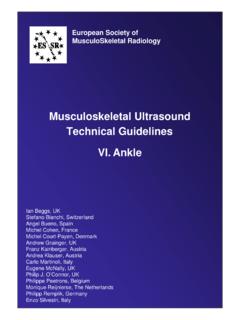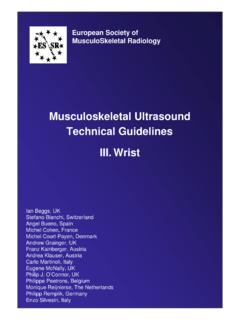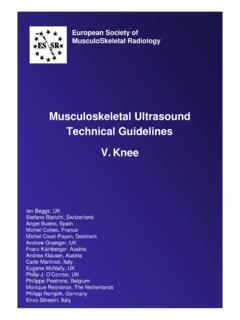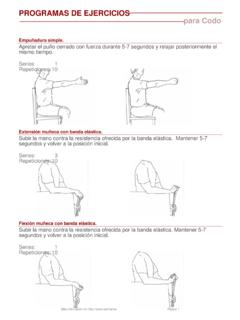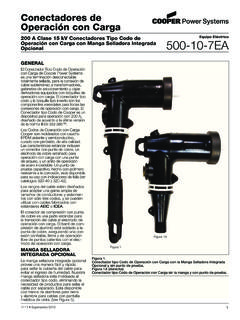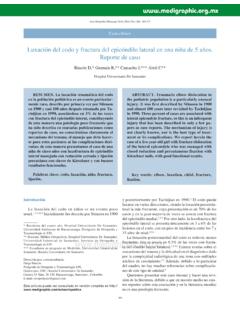Transcription of Musculoskeletal Ultrasound Technical Guidelines II
1 European Society of Musculoskeletal RadiologyMusculoskeletal UltrasoundTechnical GuidelinesII. ElbowIan Beggs, UKStefano Bianchi, SwitzerlandAngel Bueno, SpainMichel Cohen, FranceMichel Court-Payen, DenmarkAndrew Grainger, UKFranz Kainberger, AustriaAndrea Klauser, AustriaCarlo Martinoli, Italy Eugene McNally, UKPhilip J. O Connor, UKPhilippe Peetrons, BelgiumMonique Reijnierse, The NetherlandsPhilipp Remplik, GermanyEnzo Silvestri, ItalyThe systematic scanning technique described below is only theoretical, considering the fact that the examination of the elbow is, for the most, focused to one quadrant only of the joint based on clinical examination of the anterior elbow, the patient is seated facing the examiner with the elbow in an extension position over the table.
2 The patient is asked to extend the elbow and supinate the fore-arm. A slight bending of the patient s body toward the examined side makes full supination and as-sessment of the anterior compartment easier. Full elbow extension can be obtained by placing a pillow under the joint. 1 ElbowTransverse US images are first obtained by sweeping the probe from approximately 5cm above to 5cm below the trochlea-ulna joint, perpendicular to the humeral shaft. Cranial US images of the supracondylar region reveal the superficial biceps and the deep brachialis mu-scles. Alongside and medial to these muscles, follow the brachial artery and the median nerve: the nerve lies medially to the artery.
3 * * Legend: a, brachial artery; arrow, median nerve; arrowheads, distal biceps tendon; asterisks, articular cartilage of the humeral trochlea; Br, brachialis muscle; Pr, pronator muscle2 The distal biceps tendon is examined while keeping the patient s forearm in maximal supination to bring the tendon insertion on the radial tuberosity into view. Be-cause of an oblique course from surface to depth, por-tions of this tendon may appear artifactually hypoechoic if the probe is not maintained parallel to it. Accordingly, the distal half of the probe must be gently pushed against the patient s skin to ensure parallelism between the US beam and the distal biceps tendon thus allowing adequate visualization of its fibrillar pattern.
4 2 The distal biceps tendon is best examined on its long-axis. Short-axis planes are less use-ful to examine the distal portion of the biceps because slight changes in probe orientation may produce dramatic variation in tendon echogenicity and create confusion between the tendon and the adjacent artery. 2 ElbowWith medial sagittal planes check the coronoid fossa which appears as a con-cavity of the anterior surface of the hume-rus filled with the anterior fat pad. In nor-mal states, a small amount of fluid may be seen between the fat pad and the humerus. On transverse scans, the ante-rior distal humeral epiphysis appears as a wavy hyperechoic line covered by a thin layer of hypoechoic articular cartilage: its lateral third corresponds to the humeral capitellum (round), whereas its medial two thirds relate to the humeral trochlea (V-shaped).
5 On sagittal planes, the radial head exhibits a squared appearance: its articular facet is covered by * Follow the short brachialis tendon on long-axis planes down to its insertion on the coro-noid process. Legend: arrows, distal biceps tendon; asterisk, coronoid fossa and anterior fat pad; Br, brachialis muscle; HC, humer-al capitellum; RH, radial head; s, supinator muscle * **Legend: arrow, brachialis tendon; arrowheads, anterior coronoid recess; asterisks, articular cartilage of distal humeral epiphysis; Br, brachialis muscle; curved arrow, anterior fat pad; HC, humeral capitellum; HTr, humeral trochlea * ! 4 Moving to the anterolateral elbow, follow the main trunk of the radial nerve in its short-axis between the brachioradialis and the brachialis muscle down to its bifurcation into the superficial sensory branch and the posterior interosseous nerve.
6 Continue to follow these latter nerv-es according to their short-axis with meticulous scanning technique. The posterior interosseous nerve must be demonstrated using short-axis planes as it pierces the supinator muscle and enters the arcade of Fr hse passing between the superficial and deep parts of this muscle. Evaluation of the posterior interosseous nerve is made easi-er by sweeping the probe over the supinator in a transverse plane while performing forearm pronation and lateral aspect of the elbow is examined with both elbows in extension, thumbs up, palms of hands together or with the elbow in flexion. The common extensor ten-don is visualized on its long-axis using coronal planes wi-th the cranial edge of the pro-be placed on the lateral epi-condyle.
7 5 Legend: arrow, posterior interosseous nerve; arrowhead, cutaneous sensory branch of the radial nerve; Br, brachialis muscle; BrRad, brachioradialis muscle; curved arrow, main trunk of the radial nerve; RH, radial head; RN, radial neck; s1, superficial head of the supinator muscle; s2, deep head of the supinator muscle " # Legend: arrowhead; lateral ulnar collateral ligament; curved arrow, lateral synovial fringe; LE, lateral epicondyle; RH, radial head; straight arrows, common extensor tendonShort-axis planes should be also obtained over the tendon insertion. In normal conditions, the lateral ulnar collateral ligament cannot be sepa-rated from the overlying extensor tendon due to a similar fibrillar echotexture.
8 $ % 6 Check the lateral synovial fringe that fills the superficial portion of the lateral aspect of the radiocapitellar joint. Dynamic scanning during passive pronation and supination of the forearm may help to assess the status of the radial head and to rule out possible occult fractures. With this manoeuvre, check the annular ligament. At the radial neck, the an-nular recess is visible only if distended by fluid. 4 ElbowFor examination of the medial elbow, the patient is asked to lean toward the ipsilateral side with the forearm in forceful external rotation while keeping the elbow extended or slightly flexed, resting on a table. Coronal planes with the cranial edge of the probe plac-ed over the medial epicondyle (epitrochlea) reveal the common flexor tendon in its long-axis.
9 The tendon is shorter and larger than the common extensor tendon. Deep to this tendon, check the anterior bundle of the medial collateral ligament. 7 Legend: arrowhead; posterior interosseous nerve; asterisk, lateral synovial fringe; curved arrow, common extensor tendon; LE, lateral epicondyle; RH, radial head; straight arrow, annular ligament * & ' & ' More adequate positioning for ex-amination of this ligament is obtai-ned with the patient supine keep-ing the shoulder abducted and externally rotated and the elbow in 90 of flexion. Dynamic scanning in valgus stress (demonstration of joint space widening) may be use-ful in partial tears, in which the li-gament is continuous but : arrowheads, common flexor tendon origin; arrows, anterior bundle of the medial collateral ligament; ME, medial epicondyle& ( : ) $ * !
10 8 The posterior elbow may be examined by keeping the joint flexed 90 with the palm re-sting on the table. Cranial to the olecranon, the triceps muscle and tendon are evaluated by means of long-axis and short-axis scans. The most distal portion of the triceps tendon needs to be carefully examined to rule out enthesitis. 5 ElbowDeep to the triceps, the olecranon fossa and the posterior olecranon recess are evaluat-ed by means of long-axis and short-axis scans. While examining the joint at 45 flexion, intraarticular fluid tends to move from the anterior synovial space to the olecranon re-cess, thus making easier the identification of small effusions. Gentle rocking motion (ba-ckward and forward) of the patient s elbow during scanning may be helpful to shift elbow joint fluid into the olecranon recess.
